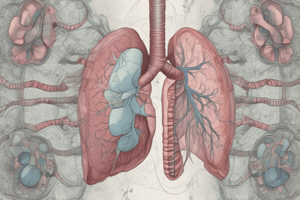Podcast
Questions and Answers
What is a characteristic of a closed pneumothorax?
What is a characteristic of a closed pneumothorax?
What is a sign of a pneumothorax?
What is a sign of a pneumothorax?
In which situation is needle aspiration of pneumothorax more likely?
In which situation is needle aspiration of pneumothorax more likely?
What is a consequence of a pneumothorax?
What is a consequence of a pneumothorax?
Signup and view all the answers
What is a characteristic of pleural pressure in a pneumothorax?
What is a characteristic of pleural pressure in a pneumothorax?
Signup and view all the answers
What is a sign of tension pneumothorax?
What is a sign of tension pneumothorax?
Signup and view all the answers
What is the primary reason for mediastinal shift to the opposite side in a pneumothorax?
What is the primary reason for mediastinal shift to the opposite side in a pneumothorax?
Signup and view all the answers
Which of the following symptoms is most likely to be present in a patient with a spontaneous pneumothorax secondary to preexisting lung disease?
Which of the following symptoms is most likely to be present in a patient with a spontaneous pneumothorax secondary to preexisting lung disease?
Signup and view all the answers
What is the characteristic sound heard on percussion in a patient with pyo-pneumothorax?
What is the characteristic sound heard on percussion in a patient with pyo-pneumothorax?
Signup and view all the answers
What is the primary factor that determines the severity of symptoms in a patient with pneumothorax?
What is the primary factor that determines the severity of symptoms in a patient with pneumothorax?
Signup and view all the answers
What is the characteristic finding on a chest X-ray in a patient with pneumothorax?
What is the characteristic finding on a chest X-ray in a patient with pneumothorax?
Signup and view all the answers
Which of the following patients is at high risk of developing a pneumothorax?
Which of the following patients is at high risk of developing a pneumothorax?
Signup and view all the answers
What is the primary difference between a simple pneumothorax and a spontaneous pneumothorax secondary to preexisting lung disease?
What is the primary difference between a simple pneumothorax and a spontaneous pneumothorax secondary to preexisting lung disease?
Signup and view all the answers
What is the characteristic sign of a patient with a large pneumothorax?
What is the characteristic sign of a patient with a large pneumothorax?
Signup and view all the answers
What is a potential complication of pneumothorax?
What is a potential complication of pneumothorax?
Signup and view all the answers
What is the primary goal of physiotherapy in treating pneumothorax?
What is the primary goal of physiotherapy in treating pneumothorax?
Signup and view all the answers
Which of the following is a surgical treatment option for pneumothorax?
Which of the following is a surgical treatment option for pneumothorax?
Signup and view all the answers
What is the primary indication for hospitalization in patients with pneumothorax?
What is the primary indication for hospitalization in patients with pneumothorax?
Signup and view all the answers
What is the most appropriate treatment for a patient with a traumatic pneumothorax?
What is the most appropriate treatment for a patient with a traumatic pneumothorax?
Signup and view all the answers
What is the immediate treatment for a tension pneumothorax?
What is the immediate treatment for a tension pneumothorax?
Signup and view all the answers
What is the primary goal of supplemental O2 therapy in patients with pneumothorax?
What is the primary goal of supplemental O2 therapy in patients with pneumothorax?
Signup and view all the answers
Which of the following patients is best treated with needle aspiration?
Which of the following patients is best treated with needle aspiration?
Signup and view all the answers
Study Notes
Pneumothorax and Pleural Effusion
- Pleural infection is a common cause of pyo-pneumothorax, which is secondary to pressure fistula.
Clinical Presentation
- Symptoms depend on the amount of air leakage, extent of lung collapse, rate of development, etiology, and underlying clinical status of the patient.
- Common symptoms include chest pain, dyspnea, and dry or nonproductive cough.
- Simple pneumothorax may present with no symptoms and is found incidentally on a chest radiograph.
- Patients with spontaneous pneumothorax secondary to preexisting lung disease may have a dramatic presentation.
- Premature neonates on mechanical ventilation may develop pneumothorax due to positive pressure and respiratory system compliance.
Radiological Diagnosis
- Chest X-ray shows:
- Hyper-translucency between the lung and thoracic cage.
- Sharp border of the collapsed lung.
- Shifting of mediastinum to the opposite side.
- Chest US and Chest CT may also be used for diagnosis.
Complications
- Cardiac tamponade
- Cardiopulmonary arrest
- Hemothorax
- Pneumopericardium
- Pneumomediastinum
- Shock
- Tension pneumothorax
Treatment
- Surgical treatment includes:
- Supplemental O2 to facilitate pleural air resorption.
- Aspiration to aspirate air in the pleural cavity.
- Tube thoracostomy connected to a water seal device ± suction.
- Thoracoscopy (VATS) for mechanical pleurodesis.
- Large or complicated pneumothorax requires hospitalization and direct mechanical evacuation of pleural air.
- Clinically stable patients with primary spontaneous pneumothorax can be treated with needle aspiration.
- Clinically unstable patients and most patients with underlying lung disease require chest tube insertion.
- Traumatic pneumothorax requires immediate decompression with needle thoracostomy followed by tube thoracostomy.
Physiotherapy
- Aims to improve distribution of ventilation, reinflate collapsed lung areas, increase oxygenation, improve exercise tolerance, and maintain airway clearance.
- Gentle coughing can be performed in small pneumothorax.
- Large pneumothorax requires increase in lung expansion, allowing air entry during inspiration and leak during expiration, and decreasing venous return to the heart.
Studying That Suits You
Use AI to generate personalized quizzes and flashcards to suit your learning preferences.
Description
This quiz covers the symptoms and signs of pleural infection, including chest expansion, percussion sounds, and breath sounds. It also includes information on mediastinal shift and dyspnea.




